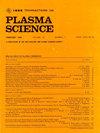Study on the Distribution of Deposition Layer on the Rail Surface and Its Influence on the Armature Start-up in Railgun
IF 1.5
4区 物理与天体物理
Q3 PHYSICS, FLUIDS & PLASMAS
引用次数: 0
Abstract
Deposition occurs on the rail surface during the start-up stage of the launching process. These phenomenon influence the velocity of the armature, the acceleration of the armature and the launching stability of the launcher. In this article, 15 experiments with the linear current density of 19 kA/mm were carried out. The morphology of the rail surface at the armature start-up stage and the start-up time of the armature were measured by a 3-D laser profilometer and a high-speed camera, respectively. Three conclusions are obtained: 1) the morphology of the deposition layer on the surface of rails is high at the edges of armature-rail interface and low in the middle of interface because of nonuniform contact pressure and temperature; 2) as the number of experiments increases, the thickness of the deposition layer on the rail surface increases and then tends to stabilize; and 3) the start-up time of the armature increases rapidly, and then tends to stabilize. Moreover, to analyze the reason for the distribution of deposition layer on the rail surface observed during start-up stage in experiments, the contact pressure, current density and Joule heating were calculated. Results show that the contact pressure of the edges of the armature is relatively high, and these areas are also where high temperature is concentrated on the surface of the armature.轨道炮轨道表面沉积层分布及其对电枢启动影响的研究
在发射过程的启动阶段,钢轨表面会发生沉积。这些现象影响了电枢的速度、电枢的加速度和发射装置的发射稳定性。本文共进行了15次线性电流密度为19 kA/mm的实验。利用三维激光轮廓仪和高速摄像机分别测量了电枢启动阶段和电枢启动时间的钢轨表面形貌。结果表明:1)由于接触压力和温度的不均匀,电枢-钢轨界面边缘沉积层的形貌较高,界面中部沉积层的形貌较低;2)随着实验次数的增加,钢轨表面沉积层厚度逐渐增大,而后趋于稳定;3)电枢启动时间迅速增加,然后趋于稳定。为了分析实验中观察到的启动阶段钢轨表面沉积层分布的原因,计算了接触压力、电流密度和焦耳加热。结果表明,电枢边缘的接触压力较高,这些区域也是电枢表面高温集中的区域。
本文章由计算机程序翻译,如有差异,请以英文原文为准。
求助全文
约1分钟内获得全文
求助全文
来源期刊

IEEE Transactions on Plasma Science
物理-物理:流体与等离子体
CiteScore
3.00
自引率
20.00%
发文量
538
审稿时长
3.8 months
期刊介绍:
The scope covers all aspects of the theory and application of plasma science. It includes the following areas: magnetohydrodynamics; thermionics and plasma diodes; basic plasma phenomena; gaseous electronics; microwave/plasma interaction; electron, ion, and plasma sources; space plasmas; intense electron and ion beams; laser-plasma interactions; plasma diagnostics; plasma chemistry and processing; solid-state plasmas; plasma heating; plasma for controlled fusion research; high energy density plasmas; industrial/commercial applications of plasma physics; plasma waves and instabilities; and high power microwave and submillimeter wave generation.
 求助内容:
求助内容: 应助结果提醒方式:
应助结果提醒方式:


